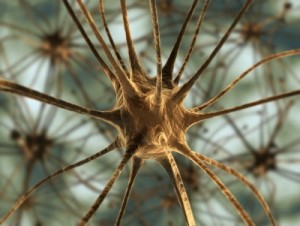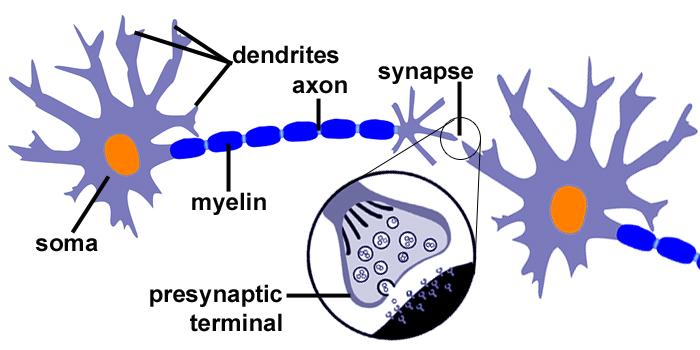Neurons
 We have roughly 86 billion neurons in our brains[1]. But unlike the common saying, we don’t just use 10% of them; we use most of them all of the time!
We have roughly 86 billion neurons in our brains[1]. But unlike the common saying, we don’t just use 10% of them; we use most of them all of the time!
Neurons are the cells in the brain that convey information about the world around us, help us make sense of the world, and send commands to our muscles to act. They are exquisitely responsive to the world around us, enabling us to learn. Learning can change the shape of a neuron, what that neuron projects to, and its signaling efficiency.
Neuron Structure
Most neurons are made up of the following parts: the nucleus (which contains the genetic instructions), the soma (or cell body), dendrites (branch-like structures which receive information from other neurons), axons (long tubular pathways which send information to other parts of the brain), and an (axonal) presynaptic terminal. The presynaptic terminal connects to other neurons via synapses. Many axons are surrounded by myelin, essentially sheaths which help axons quickly send signals over long distances.

Cartoon diagram of a neuron and one of its synapses. The soma is the cell body of the neuron, where genetic information is stored in the nucleus (orange). Dendrites emit from the soma and receive electrical and chemical signals from other neurons. The long projection is called an axon, which is wrapped in a protective myelin coating. The synapse is the point where two neurons meet. In the presynaptic terminal (highlighted in the magnified area), chemical messengers travel from the axon to the receiving dendrite of the next neuron.
Human neurons can be as small as 10μm (one thousandths of a millimeter), such as granule cells, and as big as 100 μm (one-tenth of a mm), such as Betz cells[2]. Neurons come in many shapes and sizes, but most resemble differently-shaped trees. The extent and size of the dendritic branches, the size and shape of the soma, and the size of the axon help scientists characterize the neuron type and, more importantly, help us understand its function.
Neural Communication
Neurons with long axons, or projection neurons, send information from one part of the brain to another; neurons with short axons or even no axon at all, called interneurons, interact with other neurons within a part of the brain.
If a neuron responds to a stimulus, its axon sends an all-or-nothing electrical signal called an action potential down to its axonal terminal. Action potentials are the way the brain receives, processes, and conveys information.
How the Brain Creates and Re-Creates Neurons
The brain contains other cells called glia, which serve numerous supporting functions, including providing structural support to neurons during development, repair following brain injury, construction of myelin, bundling of nerve fibers, and aiding in metabolic pathways which modulate neuron function.
For decades, the dogma was that humans could not generate new neurons as adults. Now we know that humans, like other species, can grow new neurons, but only in certain parts of the brain, such as the hippocampus, involved in memory.
References
[1] Herculano-Houzel S (2009). The human brain in numbers: a linearly scaled-up primate brain. Front. Hum. Neurosci. 3:31. doi: 10.3389/neuro.09.031.2009
[2] Purves, Dale, George J. Augustine, David Fitzpatrick, William C. Hall, Anthony-Samuel LaMantia, James O. McNamara, and Leonard E. White (2008). Neuroscience. 4th ed.. Sinauer Associates. pp. 432–4.

